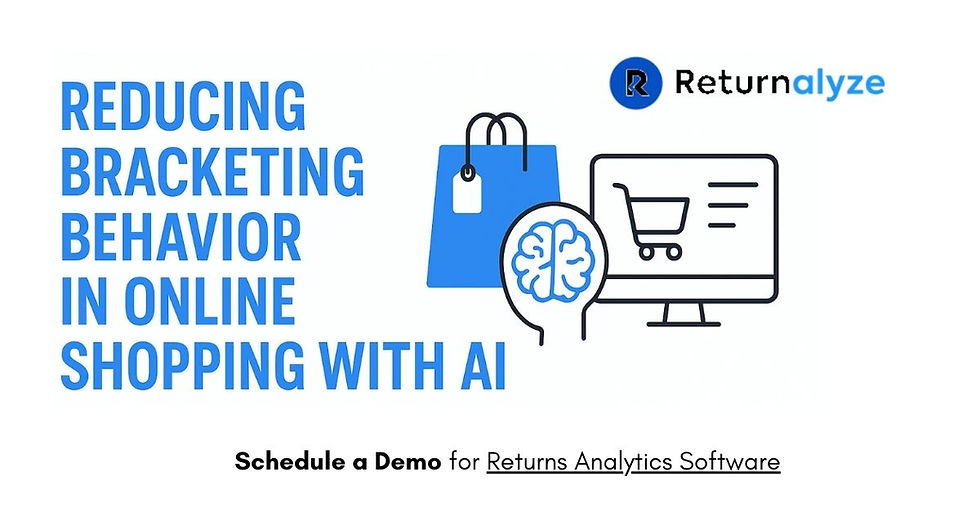Boost Customer Satisfaction & Retention by Optimizing E-commerce Return Policy
- returnalyze
- Jun 22
- 4 min read

In today’s highly competitive and customer-driven eCommerce environment, a well-optimized return policy is no longer just a backend operation - it’s a strategic advantage.
With rising consumer expectations and the growing demand for hassle-free online shopping experiences, your return policy can make or break the buying decision.
A transparent, flexible, and customer-friendly return process not only increases conversion rates but also strengthens brand trust, drives repeat purchases, and enhances long-term loyalty.
Brands that prioritize an intelligent returns strategy are not just reducing costs - they’re building a more resilient, customer-centric business model.
Why an Optimized Return Policy Matters in E-commerce
A seamless return experience reflects your brand’s commitment to customer care. Research shows that over 60% of shoppers review return policies before completing a purchase, and more than 90% are likely to buy again from retailers offering easy returns. When done right, returns can transform a potentially negative experience into an opportunity to build trust and loyalty.
Key Elements of a Customer-Friendly Return Policy
1. Clear and Concise Language
Use plain, non-legalistic language to make your return policy easy to understand. Confusion causes friction and leads to abandoned carts or customer complaints.
Do: “You can return items within 30 days of delivery for a full refund.”
Don’t: “Returns initiated outside the aforementioned timeframe are subject to the forfeiture of the refund amount in its entirety.”
2. Transparent Return Window
Offer a return window that balances your operational needs with customer expectations. While 14 days may be sufficient in some industries, 30 to 60 days is ideal for most fashion, electronics, and consumer goods brands.
Pro Tip: Highlight the return window on product pages, in the cart, and in order confirmation emails to build customer confidence.
3. Free or Low-Cost Returns
Free returns remove purchase anxiety and can increase conversion rates by up to 25%. If offering free returns isn’t viable for all products, consider:
Offering it only to loyal customers
Implementing it for high-margin products
Providing return shipping at a flat discounted rate
4. Easy Return Process
Make returns frictionless through a simplified, digital-first process:
Enable returns via self-service portals
Offer printable return labels or QR codes
Provide clear instructions and expected timelines
An optimized process leads to fewer support tickets and increased customer satisfaction.
5. Refund, Exchange, or Store Credit Options
Offering multiple return options puts the power in the customer’s hands:
Refunds: Ideal for unhappy customers
Exchanges: Reduce refund costs and retain revenue
Store Credit: Encourages future purchases and builds loyalty
Strategies to Minimize Returns Without Compromising Satisfaction
1. Improve Product Descriptions and Images
Accurate product information reduces expectation gaps - a major cause of returns. Invest in:
High-resolution photos from multiple angles
Detailed sizing charts
Videos that show products in real-life use
Customer reviews and Q&A sections
2. Use Fit Prediction and AI Tools
AI-powered fit assistants and personalization tools help customers make better choices, especially in apparel and footwear. Brands like ASOS and Nike use this technology to reduce sizing-related returns by up to 25%.
3. Educate Customers Pre- and Post-Purchase
Use automated emails, FAQs, and chatbots to:
Set product expectations
Provide care instructions
Offer styling or usage tips
4. Segment and Analyze Return Data
Use returns analytics to identify patterns and optimize inventory, descriptions, and product design. For example:
High return rates by SKU may signal sizing or quality issues
Region-based trends may highlight fulfillment delays
First-time buyers with higher return rates may need onboarding
How Return Policies Influence Customer Retention
An easy and fair return policy isn’t just a sales booster - it’s a retention engine. Here’s how:
1. Builds Brand Trust
Customers are more likely to return when they know you stand behind your products. This level of confidence transforms them into repeat buyers and even brand advocates.
2. Encourages Risk-Free Shopping
Consumers are more willing to try new products or higher-value items when returns are simple and affordable. This reduces hesitation and increases average order value.
3. Supports a Personalized Loyalty Program
Integrate return behaviors into your customer loyalty strategy:
Reward customers who exchange instead of refund
Offer points for reviews or return-less refunds
Provide exclusive access to flexible return windows for VIPs
4. Enables Sustainable Growth
Managing ecommerce returns responsibly doesn’t just help your profit margins—it also contributes to sustainability. Offer options like:
Return-less refunds for low-cost items
Re-commerce programs to resell returned goods
Donation or recycling programs for damaged returns
Return Policy Optimization Best Practices
A/B Test Policy Components
Test elements like return windows, free return thresholds, and restocking fees. Measure the impact on conversions, return rates, and customer feedback to fine-tune your policy.
Localize Return Policies
For international customers, adjust return policies to comply with regional regulations and cultural expectations. For example, the EU mandates a minimum 14-day return window for online purchases.
Regularly Update Policy Pages
Keep your return policy page up to date with:
Recent changes
Holiday-specific rules
Temporary COVID-19 adjustments
Also, ensure SEO optimization with relevant keywords like "easy return policy," "online returns," or "[your brand] return process."
Prominently Display the Policy
Add your return policy link to:
Product detail pages
Checkout
Footer navigation
Post-purchase emails
The Return Policy as a Competitive Advantage
In an era where customer experience defines e-commerce success, a strategic and empathetic return policy isn’t just a safeguard - it’s a competitive differentiator. The most successful e-commerce brands understand that optimizing returns is about more than reducing costs - it’s about enhancing trust, loyalty, and satisfaction.
Looking to turn your return policy into a powerful growth lever? Partner with Returnalyze - the retail industry’s leading AI-powered returns analytics platform.
At Returnalyze.com, we help eCommerce brands like yours reduce return rates, cut operational costs, and unlock hidden revenue opportunities through intelligent, data-driven insights. Improve customer satisfaction, boost retention, and drive profitability - all from a single platform. Start optimizing your returns strategy.



Comments